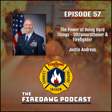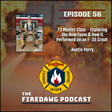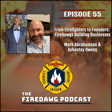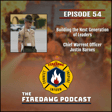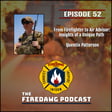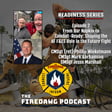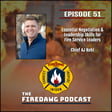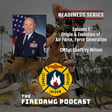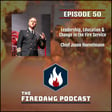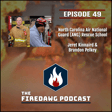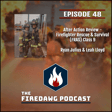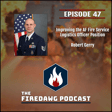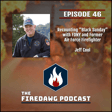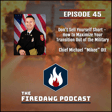Introduction to Episode 53
00:00:01
Speaker
This is the Fire Dog Podcast.
00:00:14
Speaker
Welcome, my name is Matt Wilson and thank you for joining us for episode 53 of the Fire
Introducing Master Gunnery Sergeant Marcos Martinez
00:00:17
Speaker
Dog Podcast. In this episode, Chris and I have the privilege of speaking with Master Gunnery Sergeant Marcos Martinez. Master Gunnery Sergeant Marcos Martinez serves as Fire Protection Training Analyst with Marine Corps Training and Education Command in Quantico, Virginia.
00:00:30
Speaker
Over his 28-year career in the Marine Corps, he's served with an urban search and rescue team as a drill instructor and completed a tour in Iraq during the Battle of Ramadi. Currently, he is the senior enlisted leader for Marine Corps Fire Protection.
Overview of Marcos' Marine Corps Career
00:00:43
Speaker
In this episode, Chris and I talk with Master Guns Martinez about his service, the mission and structure of Marine Corps Fire Protection and how it compares to the Air Force, among other topics. It is my pleasure to welcome Master Gunnery Sergeant Marcos Martinez.
00:00:56
Speaker
Well, without further ado, let's get into it. Marcos, man, I appreciate you joining us. Look forward to hearing your perspectives, what life's like is you know as a firefighter in the Marine Corps. But before we get into all of our talking points, just tell us a little bit about yourself.
00:01:10
Speaker
When did you join? Where you from? how long you been in the Marine Corps? And whatever else you'd like to share. All right. So I'm from a small town in Southern California in the desert.
Marcos' Early Career and Assignments
00:01:20
Speaker
Name of the town is Hopeville, California.
00:01:22
Speaker
It's a small agricultural town. Not much to do there. i Just couldn't wait to get out of that place. So I i saw the opportunity to join the Marine Corps was what's going to be the the thing to do.
00:01:33
Speaker
It took me three times to pass the ASVAB. I'm not a very bright guy. I wasn't a good student at all. um And when I did that, you know, I just wanted to be a Marine. Didn't care what job I got.
00:01:44
Speaker
um And I just got – I was lucky enough that – I went open contract and I was lucky enough to get the MOS of 7051 aircraft rescue firefighter. And the rest is history.
00:01:56
Speaker
um Went to boot camp night in January of 97. So I just ah just hit my 28-year mark recently. um First – after I went to the academy, first tour was a one-year tour in Japan, Iwakuni, Japan.
00:02:12
Speaker
After that, went to Miramar. I was there at Miramar, San Diego for roughly nine months. And an opportunity you know was was brought to us at evening muster like, hey, who wants to go to this new unit that unit that's being stood stood up called CBERF, Chemical Biological Incident Response Force?
Impact of September 11 on Marcos' Career
00:02:32
Speaker
It's like, oh that's interesting. So I raised my hand. I wanted to be high speed right at the time. you know You're young. You just want to go do cool stuff.
00:02:41
Speaker
um So I did that, right, got on the road two weeks later because orders hit like immediately. Drove cross country to Camp Lejeune, North Carolina, was there for a year. i we we were only there for a year. I said we because I was one of the first 15 firefighters to show up to that unit.
00:02:59
Speaker
And our responsibility was to do to conduct urban search and rescue. Right. So when we when we arrived a couple months later, we went up to New York City. We trained at Randall's Island with FDNY Special Operations folks up there.
00:03:14
Speaker
So those are introduction to urban search rescue. So we did that for the remainder of two years. So the first year we were in Camp Lejeune and then the the Marine Corps decided to move us closer to the national capital region.
00:03:25
Speaker
we ended up in Indian Head, Maryland. Right. So if you do the math, my first four years in the Marine
Transition to Drill Instructor and Deployment to Iraq
00:03:30
Speaker
Corps was pretty awesome. Right. I went Japan, West Coast, East Coast and the National Capital Region. I was having a blast and, you know, doing the urban search and rescue stuff.
00:03:38
Speaker
I don't know you guys have done that before, but I mean, what else can you ask for? We're climbing stuff. We're jumping off buildings. We're breaking stuff. We're moving stuff. It was a really good time. We were really good at our jobs. um So I decided to reenlist and I re-enlisted to get orders to to be a drill instructor in San Diego.
00:03:58
Speaker
So I left that unit, moved cross country or went cross country to go to San Diego from Maryland. um i was on leave to go check into DI school and that's when September 11th happened. right So automatically – I mean um imagine this. you know if It was early in the morning on a – I believe it Monday morning.
00:04:16
Speaker
And ah TV, you know, my mom turns the TV on. She wakes me up and she's like, hey, something's happening in New York City. And I turn the TV on and I see, you know, the first tower had just hit the hit the World Trade Center.
00:04:28
Speaker
And I'm thinking, oh, my God, like in my mind, like I know guys that were there because they were the folks that trained us. And I know exactly what's happening on the ground. um And then the second plane hit and, you know, those emotions start the anger, the the frightened, the frightened emotions, et cetera, et cetera.
00:04:44
Speaker
And then you see the buildings collapsing. I just remember to my thinking to myself, like, oh, my God, like,
Training Naval Officers and Deployments
00:04:50
Speaker
this is it. This is what we've been training for for two years. And I can't be there. Right. So it was really frustrating.
00:04:55
Speaker
Immediately, I got on the phone, talked to my buddies, you know, because you You know, they were they were getting spun up to to roll up to New York City or even the capital or the Pentagon. Right. Because ah the plane also hit the Pentagon.
00:05:07
Speaker
um So it was really frustrating sitting on on sidelines after two years of doing a lot of a lot of intense training. And then I was a rescue team leader, too. So automatically. Right. I'm thinking about my guys like, holy crap. Yeah.
00:05:18
Speaker
Come to find out, right, they didn't spin up the unit. They didn't deploy because, like I said, it's a chemical, biological its response force. They didn't want to use that capability just yet because we just didn't know what was happening at the time. But um anyhow, that was that was me going on leave to go to checkk check into drill instructor school.
00:05:36
Speaker
Went to drill instructor school, did three years, three and a half years as a drill instructor in San Diego. um You know, and you know, you're training this whole generation of Marines to go to war because Iraq kicked off and it was nice. It was hot and heavy.
00:05:49
Speaker
Like, well, got to go do that because ah originally my my plan was not, you know, like everybody else do four years and get out. But then I became a drill instructor. The war kicked off. Well, I got to go do that now. Put my money where mouth is. ah Requested first deploying unit. Just so happened to be Yuma, Arizona, 45 minutes from where I grew up. Right. And I wanted to travel and adventure, but they sent me back to the desert.
00:06:13
Speaker
um Did the Iraq tour, got back and um was a Ramadi alert for first three months, then El Tecatum for the follow on three months.
00:06:26
Speaker
Performed you know all the all the things, fire department, firefighting that we trained for, both on a station and off off station. We can get into that later, too, if you like. um Once I was done with Iraq, went back to Yuma, and then I decided, well, what's next, right? Because nobody the war was in Iraq was was dialing down.
00:06:46
Speaker
was like, well, hey, I want to go do drill instructor duty again because I felt i I really did well. So um I volunteered one more time, but this time it was to go train naval officers right through their initial pipeline. So I got orders. i I requested it. I got it.
00:07:03
Speaker
And that was in Newport, Rhode Island.
Current Role in Training and Education Command
00:07:05
Speaker
um And i I moved in March, and I was not ready from going to from the desert. Fairly nice weather, too frigid cold up in New England. That was a shocker to the system.
00:07:17
Speaker
Anyhow, did that for another three and yeah three years and like three months. um And again, you know Afghanistan was kicking off. Called the detailer or the monitor is what we call them.
00:07:27
Speaker
It's like, hey, next deploying units. Like, oh, perfect. I got just the unit for you, Yuma, Arizona. So I go cross country one more time. And ah but, you know, that was it was a silver lining there. ah You know, it's got to go. I got to go to Iraq or sorry, Afghanistan did that deployment.
00:07:45
Speaker
And then, um yeah, I got back to Yuma. And then after that deployment, got selected to Master Sergeant. And then I got to go overseas to Japan again, Iwakuni, Japan, where I started. So that was really cool to go as a young Marine and then go back out there with my family.
00:08:01
Speaker
did a three-year gig out there. And then, uh, Miramar again, after that, uh, spent, uh, about a year and a half at the fire department on the air station, on the airfield, I should say the R station. And then, uh, some headquarters spots got selected a master gunnery sergeant and then, uh, up to headquarters, Marine Corps is, uh, where we mostly end up.
00:08:21
Speaker
So I've been here, um, roughly three and a half years. Um, and, uh, ah I'm a training analyst for training and education command. So under my umbrella, all threeing all things training in in our MOS is what I'm responsible for, right? From, ah you know, we're going to get into integration and ah the WTI bringing the the Air Force firefighters in.
00:08:45
Speaker
We just recently had our readiness review for our community in Texas at the at Goodfield Air Force Base at the Academy. um A lot of goodness came out of that.
00:08:57
Speaker
So, you know, finding training gaps that we have in our in our community and trying to fill those gaps and in any way that that I can, you know, and and training touches so many things. So it's it's been a real cool adventure to just start, you know, kicking over rocks such as Frass, right? I listened to your podcast when you talked about Frass, gave you guys a call and boom, we were in there. And now we have of FRAS, United States Marine Corps FRAS course down at Capital Juniors. So kudos to your efforts on that.
00:09:28
Speaker
That's really awesome.
00:09:30
Speaker
Yeah, so I got two more years left. I have i can only do 30 years in Marine Corps and it's going to be bittersweet. um I just don't know what I'm go do when I grow up anymore. So I'll figure that out as it comes.
00:09:42
Speaker
Well, Marcos, that's quite the career. I i didn't realize you've been in 28 years, man. That's impressive. nineteen ninety seven 1997. The fact that you've stuck around in the Marine Corps that long through Iraq, Afghanistan, all the PCS is, it's impressive, man. it Hats off to you.
00:09:56
Speaker
And yeah, I guess there's so many things I'd like to dig into as you're talking it. You're talking about Ramadi and things you did for urban search and rescue. I was wondering for that, have you, was that a part of a task force?
Urban Search and Rescue Training
00:10:12
Speaker
ah like a FEMA task force. I mean, I guess that's probably pre pre FEMA tasks, task force. I mean, FEMA and the Homeland Department of Homeland Security kind of stood up post 911. So maybe that was before all of that.
00:10:26
Speaker
So, um, yes, that was before the task force, but, or before Homeland Security. um But when we When I was in Maryland, we did reach out to one of the FEMA teams here in Fairfax.
00:10:41
Speaker
And that was an island. Yeah, task force one, Virginia task force one, I believe. ah Yeah, I think so. It's been so long. um But yeah, I mean, we meet. You know, back then, it was communication was not not great like it is now. I couldn't just...
00:10:54
Speaker
Google it on my phone. I didn't even know how to use a computer back then, to be quite honest with you. So me and another sergeant, we just jumped in one of the our vehicles and like, hey, let's go find this task force that's Urban Search and Rescue and ask them if they want to train with us. So that's what we did.
00:11:09
Speaker
We just jumped on a vehicle, drove into Fairfax. ah We had an address. yeah You follow the street signs or whatever. I think it was a Yahoo Maps by back then. MapQuest. Printed it out. MapQuest. We just knocked on their door and said, hey, we're Marines. This is what we do. We want to see what you guys have and open up the possibilities for training. And they they opened they welcomed us with open arms.
00:11:31
Speaker
We got to see how they have their pack out and they the things they do you know in a very fast, rapid time frame to get out the door and deploy anywhere around the world. And at that moment, um At that time at at our unit, you know, we were still trying to figure it out and it's like boom, right in front of us. So that was a really cool experience.
00:11:50
Speaker
I had to leave shortly thereafter for drill instructor school, but but yeah, that's, that was that experience. Yeah, I had the fortunate experience to be taught by some of those Virginia task force guys and just I mean, the best of the best just really it what it takes to be in in a task force of him task forces. I don't know that people realize the the amount of experience and certifications. It's just they don't just pick anybody. You know, those guys are incredibly knowledgeable.
00:12:18
Speaker
um with what they do they taught me i was in a class for structural collapse um probably not quite to the level that you sounds like you did for as long as you did but you know just a few few training classes for me and they were actual hands-on experience and you know executing on urban search and rescue although the you know the opportunities are pretty few and far between but man awesome stuff yeah we also had the opportunity to go out to uh Oklahoma City, a guy by the name of Mike Shannon, he ran a course out there and it was it was real world, right? Like he had connections with the concrete companies and they would just put slabs on top of slabs on top of slabs.
00:12:57
Speaker
And it was it was dangerous. It was the real deal. Like you couldn't mess this up or it's going to be catastrophic, right? It was a little wild, wild west. It's Oklahoma, right? So the rules are a little different there. Right. that was That was a real deal. I call it you know the USAR boot camp back then because, I mean, you got on deck. like We set up a tent. We slept in that tent. Then we went into 12-hour shifts, and that was really neat. So we were really good at our job at that time, and that that was the only thing we needed to do was be prepared to do urban search and rescue
Mission and Structure of Marine Corps Fire Protection
00:13:25
Speaker
And typical our typical week was you know Monday, you check your gear. Tuesday, Wednesday, Thursday, we went out to our training area. And then Friday, we cleaned it up and rinse and repeat. um you know, and then sprinkling all the Marine Corps requirements, rifle range, PFT, CFTs, any administrative things.
00:13:41
Speaker
It was a great time. we job but But as a PFC, I mean, or, you know, whatever the rank was at the time, I mean, that, like, what more could you ask for? You know what I mean? Like, gosh, yeah, you're you're right about that. I mean, a year in Japan and then going right into that, man, I feel like you you got pretty lucky with that opportunity. Oh, absolutely.
00:14:00
Speaker
Yeah. Super lucky. Yeah. That's get you. They hook you early, right? Yeah, exactly. Yeah, they got them 28 years later, man. Hey, tell us real quick, with your role at headquarters, the Air Force firefighters listening are going to be familiar with you know our Air Force fire chief.
00:14:15
Speaker
We've got a career field manager. Are there similar roles for Marine Corps fire protection? Yes. So we're kind of spread out. So um we have a what we call off field me.
00:14:27
Speaker
um He is at one of our headquarter units. Right. And he controls. he's He's the ultimate decision where people go working with mad power. he connects the dots with all things, acquisition, et cetera. Right.
00:14:41
Speaker
I would say that. He has a lot of the responsibilities that the team down at Tyndall Air Force Base have. right so So if you take the four master gunnery sergeants up at the headquarters Marine Corps level, um we all have the responsibilities of of what all your team members down at Tyndall have.
00:15:00
Speaker
right So their career field manager. is what our opfield SME is, right? And that's at a different headquarters unit. Me as a training analyst, I work with Alton Robinson um with our fez our our certification process, our CDCs.
00:15:16
Speaker
And he's given me the keys to the castle, like, hey, Alton, can you know can I manage the... the practicals and and making sure we're doing those assessments properly. And and i went ah I went to a couple with him.
00:15:28
Speaker
He told me exactly what they look for. so um we've been doing that. We have regional fire chiefs at our three locations, Japan, West Coast, East Coast. And we do our best to try to get out there and go ahead and inspect or do the quality checks for the CDCs. you know That, amongst other things under my umbrella, like I said, but that's that's what we do up at headquarters of the Marine Corps.
00:15:51
Speaker
for our fire service.
00:15:56
Speaker
let's ah i want to kind of dig deeper into that, the kind of the mission and the structure of Marine Corps fire protection. You kind of talked to us about the Marine wing support versus installation and kind of that construct.
00:16:12
Speaker
Okay. Yep. So I will start with installations. So at the installation, of the I would say the Marine Corps air stations, right? That's where we reside as firefighters at the airfield in the ARF department, right? And we don't have enough people. Like Manning's been an issue for a very long time, right? We require 43 firefighters to execute the mission there on the airfield. And those are shifts. And then you got your administrative support folks also.
00:16:40
Speaker
So then you have the MWSSs, so let me back up. And that's only the ARF mission, period. you um Then we have our MWSSs, right? So when and a Marine Wing Support Squadron, when we deploy forward, we are there to support the aircraft, right? And that entire squadron is very similar to your, I wanna say your combat wing.
00:17:02
Speaker
Deployable combat wing is what they're calling. It's Air Task Force and eventually deployable combat wing. Correct, where you have all the infrastructure for ah essentially a ah ah base to function and operate, right? So that's that's what the MWSS does.
00:17:16
Speaker
We lost the mission to, or we we did not, after, one of the one of the products of Force Design was that we will no longer, as an MWSS, be responsible for the base camp.
00:17:29
Speaker
It used to be that way, but now we are just responsible for everything that happens on the airfield. And that's where we come in. Right. Air Force. Sorry. Marine firefighters. We are the ARF.
00:17:41
Speaker
We are also responsible for those hangar spaces, the inspections and anything that happens, you know, a fire or fire. or first aid or EMS call, like we're responsible for those things.
00:17:55
Speaker
And then also the hazmat operations level of of the mission, right Because we have a lot of hazmat on the airfields. So that's what we do at a deployable unit. And then, you know, everything else that that entire MWSS has, we have engineers, we have our expeditionary airfield guys. So your MOS guys with the arresting gear, they do that. They they light and it they also mark the airfield.
00:18:18
Speaker
And if we have to go make LZs, they're also a part of that. um And then, of course, your communicators, your motor T folks to move stuff around, your sweeper guys, your I mean, you name it, everything that it takes to operate an airfield is within that MWSS.
00:18:33
Speaker
Yeah, the focus is airfield in the Marine Corps, it seems, with the Marines. And then, correct me if I'm wrong, they ah the like civilians work and any anything else, any base support or like in garrison base support, right, as far as the fire department is concerned.
00:18:51
Speaker
Correct. There's a little bit of connective tissue there. There's there's there's opportunities for Marines to go and and and do you know a six-month, one-year, couple-year tour right alongside those civilians to get some experience. Is that right?
00:19:03
Speaker
At some locations. So some locations, correct. um ah There's a couple of of MOAs, MOUs throughout the Marine Corps where we'll send one Marine over the fire department to ride on their vehicles.
00:19:15
Speaker
um But we lose a person, right? So it depends on manpower, right? And it also depends how many Marines from the MWSS, when they're not deployed, go over and through the fleet assistance program, the FAP program.
00:19:28
Speaker
to integrate or to help out with the manpower at the installation, right? So no matter what, where you're at, whether you're at an MWSS or an installation, we're ultimately responsive for combat readiness. sure Either you're at the installation supporting sortie generation and increasing pilot readiness, or you're at the MWSS where you're preparing to deploy um at locations like in 29 Palms or overseas. they've been They just had a group go to a flag, right?
00:19:56
Speaker
Yuma, Arizona, et cetera. Okay. Just to, from my understanding, just like is it, I always try to like visualize these things. um The MWSS. So are we saying that, let's say if on the airfield side of 29 Palms, I don't know that there is airfield. i assume that there is. There is. um If that unit could, can that unit deploy? And if they do, are you like uprooting the entire airfield side ah the entire airfield fire department and are the, all of them going to where you have no airfield fire protection?
00:20:34
Speaker
So yeah. yeah So in the case of 29 palms, there is a small detachment. It used to be an entire MWSS that was residing there, but again, force design made a big cut. And now there's just a small contingent of engineers, uh, firefighters, uh, expeditionary, airfield, Marines and motor T operators and, ah
00:20:56
Speaker
maintainers. Refuelers probably. Refuelers, exactly. Yeah, they're, and they are at a non-deployable unit. Okay. That's small contingent. It's roughly 84, 85 Marines. Okay. They're supporting that. And they're responsible for the airfield all the time.
00:21:11
Speaker
Correct. And they're active duty Marines. Correct.
MWSS Training and Deployment Cycle
00:21:14
Speaker
And so at what point, if I'm there and I guess what units are getting tasks to deploy, do you have to PCS out or PCA out of that unit into a deployable unit? And what is that deployable unit doing day to day?
00:21:30
Speaker
Okay, yep, so we have MWSS throughout the world. We have three East Coast, three at West Coast, and three overseas. And the MWSS is that deployable, like deployable combat batw wing equivalent, the deployable unit?
00:21:43
Speaker
That's correct. Okay. Yep, so whenever, so um on the, So whenever you're not deployed, you're back at home station. You are you are increasing your combat readiness, right? So they're responsible for conducting a few activities, right? One of which is FARPs, Forward Arming Refueling Points.
00:22:04
Speaker
There's BRAT, Base Recovery After Attack, ADR. Airfield damage. yeah but And a lot of the similar things that you guys do on your end. ah Those are just some examples, right? So and that's what they're training for. They're they're all all of their training, preparing for their their cycle of deployment.
00:22:20
Speaker
yeah So they can do it at home stations. Sometimes they they are tasked to go support exercises such as WTI, weapons tactics instruction course out in Yuma, Arizona.
00:22:31
Speaker
Sometimes they do it at SLTE, service training level exercise in 29 POMS. And sometimes they get tasked right to go out to the Pacific or go out to Norway.
00:22:43
Speaker
And that's where they're getting those those hitting the the checks in the box to to show that the commander, the commander to show the their commanders, their colonels, that they're ready to deploy. Okay. So they do have opportunities to sometimes integrate into the fire department's go-on responses, but their primary responsibility is to train, prepare for war, and they're assigned to that unit immediately.
00:23:06
Speaker
as While they're assigned to that unit, correct? Correct. Okay. um And how long how long do they stick with that unit before they move to some, like, maybe non-deployable unit? or Yeah, so when they get moved when you get orders to an MWSS, you're typically there for entire enlistment, three years minimum. Yeah.
00:23:23
Speaker
Unless they've got your one-off, like, hey, we want to switch over. um say Say you have a Marine at the installation that wants to go do all that stuff, and maybe there's a Marine that really doesn't want to, or i can't say that. Maybe there's circumstances where it's best for the Marine to be at an installation at a non-deployment. Family dynamics, injuries.
00:23:44
Speaker
yeah and And those are onesies and twosies. We'll look at everything, and then that can happen. you know In the past, when Iraq was kicking off, um You had Marines that, you know, were having kids or whatever the case may be. Sure. And it was an easy phone call to our monitor, like, hey, this kid at the installation wants to deploy.
00:24:00
Speaker
It's best if we just leave this one back on this go around and we would make that switch. yeah Roger. But usually it makes it makes complete sense. So as you're mentioning that MWSS, it's just like an air task force and a deployable combat wing in the Air Force. Now, this is a new concept for us. It sounds like it's not for the Marine Corps.
00:24:19
Speaker
So we're trying to we're trying to figure ourselves out. We're trying to learn because, you know, in our through global war on terrorism, we've We've done a crowdsource kind of deployment where you are picking one or two people that are on, you know, a personnel UTC that go into absent, um, and then connect with other ones, Z, two Z's from across the United States or Indo pay com or you safety or, um, Europe. Right. And they all connect to come together.
00:24:48
Speaker
Um, So that's how we've been doing business, right, over the past two decades. And it's worked and it's, you know, there's a reason that we started doing business that way in the Air Force. But now we're, you know, now they've realized and credit to, you know, General Brown, who is our Chief of Staff of the Air
Comparison of Air Force and Marine Corps Deployment Models
00:25:04
Speaker
Force. And now he's the Chairman Joint Chiefs of Staff, General Brown.
00:25:08
Speaker
He, a few years ago, back in 2018, so more than a few years ago, 2019 so, um you know, he wanted to have,
00:25:19
Speaker
combat or what are they called? You know, the um the Army Combat Brigade or the ah nave Naval Carrier Strike Group equivalent of the Air Force. We didn't have that, right?
00:25:30
Speaker
And so really we we were being nickel and dimed and in supporting all of these. The Air Force was just overworked and overused. He wanted to have a unit of action that was equivalent to those others, you know, to the sister services, so that it made sense, so that we looked like and we made sense to the chairman and the Joint Chiefs or the Joint Chiefs of Staff, right? like Like, you when you need to go to war and you need an Air Force unit of action, like you would need an Army unit of action, like I'd just go and grab an Air Task Force, a Deployable Combat Wing, um and they go and do war, right? They do what you need to do.
00:26:05
Speaker
And so anyways, we're in that transition period, right? And that idea kind of started... It was an idea back as far back as, you know, World War II and up until the 1980s. And then we went away from it through the 90s.
00:26:21
Speaker
But ah now we are going through our transition period trying to kind of relearn how to do business. And so... Just a little bit of context. And I always like to i always like to use this as a teaching moment, too, for any listeners, too. Because it's hard for me to even to understand conceptualize, too. And so I like to like say it out loud to try to help help myself and some others understand it. So that's what an air task force is.
00:26:46
Speaker
And then, so what we're going to do is Right now, and there's there's a handful of Air Task Force established and so you know stood up throughout the the United States, four, five, or six.
00:26:59
Speaker
And they are taking from like four different bases, four different installations, or where they're taking people from. And the idea is that they join up periodically to train, and then when their time comes to deploy, which the first ATF is supposed to deploy,
00:27:16
Speaker
this fall, October, um then they get up and go together, right? Eventually, our deployable combat wing is going to look like your MWSS, where it's all of that deployable combat wing in one geographic location for two, three years, kind of like how you explained, and you know when it's their time to go. And their entire purpose in life is to train for deployment and not to support and garrison operations, although they can do that simultaneously.
00:27:46
Speaker
um but their primary responsibility is to be ready for that deployment, and then they pick up and go. So anyways, just a little bit of a history, and maybe you understood that, but yeah or you already knew about that. That's the way we do it now.
00:27:59
Speaker
When we're back at home station, we fap our folks that are – we only keep a small contingent at the MWSS for equipment readiness and some of the training readiness things. But then everyone else goes to the station to help out there.
00:28:12
Speaker
Roger. And then when the balloon goes up or there's an exercise, they punch out. Yeah. but it's good to, I feel like it's good to be on a same, a similar sheet of music. So go ahead, Chris. So tell us, so on deployment, you know, and kind of another transition the air force is going through is thinking in the whole hub and spoke model where like Matt said, we're, we're used to plopping down, you know, in a location and setting up a fire department with, you know, 70 firefighters, maybe.
00:28:39
Speaker
And we're we're learning that we've got to you know, pivot to more of a decentralized command maneuver warfare type model. Am I correct in understanding that's not really a new thing for the Marine Corps, thinking in ah a hub and spoke ah deployment model for firefighters?
00:28:56
Speaker
Correct. So we we did that in Iraq and we also did that in Afghanistan because we had our, let's see, I'll i'll use Iraq, for example. um our Our big bases were El Tecatum and... um Al-Assad, right? So East Coast units would go to Al-Assad, West Coast units would go to TQ for short.
00:29:15
Speaker
And then from there, we had our our other outlying sites, right? So when I was in Iraq, our headquarters was... at TQ with our bigger contingent of Marines.
00:29:26
Speaker
And then we had four other – no, three other locations. We had Ramadi, Fallujah, and KCV, Korean Village something. KV is what we called it.
00:29:37
Speaker
um And those are all small contingents. So, for example, on Ramadi where I was at, I only had ah seven firefighters. Correction, nine firefighters. We ran 24-hour operations for four l z sorry three LZs at the time.
00:29:52
Speaker
And if anything were to happen out in town where they needed some fire suppression, then we would roll outside the wire. with attachments of security, et cetera. um and And we were tired, right? um Anytime we were never off shift, there was no shift that wasn't a thing.
00:30:08
Speaker
We were always on call, right? So if aircraft were gonna land, we were there to to watch them land and take off safely. When there's something that happened at the um the flight aid or the the aid station there at medical run by Charlie Med on the army side, and then we were there to help them out because they were also low on manpower, right? We have those medical skills that would help them out. So we were doing things outside of the box that we wouldn't normally do. We're but pushing IVs, doing blood draws, litter carries, triage, right? when When somebody would, you know, ram a vi and a V-bed into a public bazaar, right? And that causes a lot of carnage and all of those victims would be brought to the ah the aid station and and we would just go to work helping those folks out.
00:30:53
Speaker
um So that was Ramadi in Iraq, right? So we we were already dispersed in small teams to support airfield operations. um You know, fast forward to to Afghanistan, same thing. We were dispersed throughout the area of operations.
00:31:07
Speaker
um So it's nothing new, right? To answer your question, nothing new. We just have... ah Now we don't have the luxury of roads, you know, when we're talking out in the Pacific, distribute operations.
Equipment Readiness and Integration Efforts with Air Force
00:31:20
Speaker
um So with the Marine Corps still trying to figure out how we're going to crack that nut um and how we're going to be able to maneuver on our own without, depending on the C-17s or the C-5s that the Air Force was helping us.
00:31:31
Speaker
C-130s even. Yeah. So we only have so many C-130s, right? So then it becomes a priority of the task force commander out there. Marcos, I'd like to dive into some of the equipment. So you were mentioning like if there was a fire need out you know in Ramadi, if if something was on fire, yet contingent to seven firefighters.
00:31:49
Speaker
What does that look like with equipment? Yep. So we had a in Ramadi specifically we had a P-19, one P-19. We had a rescue vehicle that was a it was just a Humvee and we kind of went to work and made it work for ourselves. so you just use firefighter skills as Marines, really, if it were extrication and then medical treatment.
00:32:12
Speaker
Correct. Yep. um And we also we were we were also we played a pickup game. Right. What I mean by that. So I did half of my tour in Ramadi and half of my tour in TQ.
00:32:23
Speaker
um And we were also helping with like a fly out fly away type rescue capability. So we would get with Dustoff, which is the Black Hawk. medevac squadron if they needed our help to do whatever then they would call us and it happened one time right so with us we we got uh we're it was around 1100 sorry one night got to bang on the door like hey we gotta go and Me and three other Marines, well, we jumped in a Black Hawk. We took Stokes basket with like a, you know, our our our so our our small kit of ah equipment, right, to to be able to get somebody out of a vehicle.
00:33:05
Speaker
Jumped in the Black Hawk, went out and and went to work, right? Luckily, by the time we got there, because it was an IED that blew up a Humvee. Sorry, I should have started out with that. Humvee Marine was trapped.
00:33:16
Speaker
We got the call. We flew out. And then but luckily they pulled him out by the time we got there, loaded that Marine up in the helicopter, flew him back to the air base. And then, you know, they we we put him in medical and we went back to back to our little huts.
00:33:33
Speaker
And, um, that was quite the experience, right? Cause you go from like almost falling asleep to boom, you're, you're in action, just like any firefighter. Um, and we get back to the, back to our hooches and it's just like, wow, what what just happened?
00:33:48
Speaker
And it seemed like a dream the next night we woke up, right? Cause we're fully kitted up. Um, with our our rounds and our sidearms and we're going to some good work. Yeah. So it sounds a lot like, so air force had what we called Rams teams and maybe Chris knows the acronym. I don't, I can't think of it off the top my head Rams.
00:34:07
Speaker
It's kind of a, exactly what you explained outside the wire, ah rapid extrication capabilities. So Humvee rollover, or you know something of that nature. um Sometimes the firefighters would work alongside Air Force pararescuemen, because pararescuemen are our capability in the Air Force for exactly what you kind of explained, like um outside the wire, advanced medical treatment and extrication.
00:34:31
Speaker
Um, and they're, you know, their, their purpose in life is really to go and, and say, treat and save down pilots really as the origin of what a pararescue men is for. But, you know, in G Watt and Afghanistan and Iraq, they, we worked alongside them and because we have medical treatment capability and training. So, uh, but anyways, what you explained sounds like a Rams team.
00:34:52
Speaker
I wonder, you said you're kitted up, um, did in In Iraq and Afghanistan, did your Marine firefighters have ensemble? Did they bring along firefighter structural ensemble or proximity gear?
00:35:06
Speaker
Yeah, I believe we had like one debt and it was just the proxy gear in a bag. So if you wanted to send one guy into an IDLH or in a hot environment, then you would doff all of his IPE, maybe put on an ensemble and take care of business?
00:35:23
Speaker
Correct. Yeah. Interesting. It was very minimal, like anything we could carry in a Stokes basket, right? Because we also have our packs with, sure hey, in case the the helicopter had to leave us in place and we had to go back with the convoy or continue with their mission.
00:35:35
Speaker
That was also part our contingency plan. Because, we I mean, again, we're going through this transition where we're trying to understand how to have these distributed operations, right? With a minial minimal logistical footprint.
00:35:48
Speaker
um And when you start adding in firefighter ensemble, SCBA, I mean, things get complicated. And then, ah you know, the airmen and the Marines are wearing IPE helmets, vests, um carrying whatever, potentially weapons.
00:36:00
Speaker
You know, how do you put on structural ensemble or protective ensemble with that stuff? You just, you really can't unless you take everything off. Yeah. Well, in Iraq, what we did is going into Iraq, um we were told like, hey, if you're going to if you're going to bring gear, bring oversight to gear, like buy oversight stuff that fits into all your PPE. And that's what we did.
00:36:21
Speaker
Yeah, we're not even talking about JS list. you know i don't know if you guys had to carry that. up I don't think there was much of a threat. um I mean, you would know better than Ken Biles.
00:36:31
Speaker
Yeah. I know when we initially invaded Iraq in 2003, I know that some of those units were actually wearing... They they were in MOP1 as they were kind of moving into Iraq. Mm-hmm.
00:36:46
Speaker
But anyways, yeah, just a whole lot of things to consider. And gosh, there's so much to dive into there. um I would say, you know, out of all that, what what I learned is, you know, we have our specialty.
00:37:01
Speaker
And I think you guys are going in the right direction, right? Where you're or your you're ready to do many things, right? Capable, agile airmen, is I think what you call it. Yeah. You know, you can't, we can't just be right. Multi-craft, right. Because there's fewer people. So fewer, uh, a lighter or a smaller logistical footprint and also a lighter or smaller manpower footprint.
00:37:23
Speaker
And so, yeah, you have to be able to do multiple crafts and the Marines I was talking to last week, those at, uh, at K Bay. And when we were in Hawaii, they were mentioning to me that they, the way that it's constructed now,
00:37:38
Speaker
is that our version of agile combat employment um at the furthest point of our fight is what we call a ah spoke or a contingency location, which is even further out, where we could have as few as three firefighters.
00:37:54
Speaker
And the equivalent in the Marine Corps, from my understanding, is those firefighters supporting a FARP. a forward armament refueling point. And their primary responsibility there, of course, they're firefighters and they you know firefighting, but their primary responsibility or the primary mission of the Marine Corps at that place is refueling.
00:38:16
Speaker
Correct. And so they they know refueling and they bring refueling bladder with them and they create refueling points. And but right now, I think you guys are going through um you're trying to develop or see you know understand or figure out what the ARF capability looks like.
00:38:39
Speaker
And right now it's a Halon extinguisher, am I correct? Correct. Right. And so that we're kind of collaborating at the higher levels of Air Force Fire Protection, Marine Corps Fire Protection, like... Gosh, how, what does it look like?
00:38:53
Speaker
and And the Marine Corps like, how do we do what you guys are trying to do? Because we're trying to incorporate a Polaris dagger. We are going to incorporate what the Polaris dagger um and putting on like 150 gallon, 95 gallon per minute pump, you know, some kind of capability.
00:39:10
Speaker
yeah And you guys just don't, you can't do that because the airlift capability that we have isn't what you have. correct So what we're we are getting after that issue, right? So we're currently,
00:39:25
Speaker
So the current vehicle we have is the P-19R, right? And it takes a C-130 to move that, or sorry, a c seventeen to move that thing. Yeah, the thing is massive. Yeah, so that would be at at your bigger locations, right?
00:39:36
Speaker
And just for the listeners who, I'm sorry to interrupt you, Marcus, but I just want to hit this P-19R. This isn't what we understand as a P-19 of the Air Force. This thing is like tailor-made for the Marine Corps. It's just this giant olive drab.
00:39:50
Speaker
um ARF apparatus, right? And it doesn't, I'm not sure what the manufacturer is, but it doesn't really look like a P-19 that we understand in the Air Force, right? This thing is huge and it takes more than a C-130 to move it, right?
00:40:02
Speaker
Correct. Yeah. And, you know, if it was it was developed during, you know, post-Iraq and then through the Afghanistan phase, and it would be it be perfect if we were still in a land battle like like like them, right? We just didn't know what we didn't know.
00:40:17
Speaker
you know Fast forward now, we've we've we realize we need to be self-sufficient, and our platform to do that on is a C-130. So we have a requirements document that's been approved.
00:40:29
Speaker
right We're approved to go after the P-19 – or I'm sorry, a C-130 transportable ARF apparatus. right It can be a P-19 Charlie, as the Air Force has, or something else. right It just has to be C-130 transportable.
00:40:46
Speaker
and have the ARF capabilities. um that We just have to go fight for money, right? So we have folks that are are doing that and and going through that, busting through that red tape to get those funds locked in.
00:40:58
Speaker
And now we are going to go after our RIS, our Rapid Intervention System, right? We have to go after a capability, right? We can't fall in love with the thing, the dagger or the mark werent mark one, correct?
00:41:11
Speaker
that's That's what we gave. yeah Yeah. There's a little history there. Right. So we have to you have to tell them, hey, we want it to be – it has to be MB-22 transportable because it's the smallest platform. It has to be taken that way. It's got to – then we have to put all the parameters, the thresholds that we expect it to perform in off-road.
00:41:30
Speaker
you know If we want to say –
00:41:33
Speaker
We can use two factors and put those into our requirements, et cetera. But that's going to be – we still have to put pen to paper. We have a pretty decent product right now, but we just need to refine it.
00:41:43
Speaker
um There's more to follow on that. But we don't know if it's going to be a trailer that can be pulled by a prime mover, a ULTV, because we also have that limitation that the commandant said you can only use these two prime movers, which are ULTVs.
00:41:55
Speaker
um And, you know, the space available and is in ah in an Osprey. So, again, it might be something similar to the Dagger that has something the back of this ULTV or it might be a trailer. We just don't know yet.
00:42:08
Speaker
Okay. Interesting. Yeah. You guys are kind of still trying to figure it out too. And, um, we got the thumbs up, uh, from, uh, chief Wilson. Hey, if we're, if you see a dagger jump on it and you can use it, so we'll see what that happens. Yeah, man.
00:42:20
Speaker
Yeah. We want to practice. it you get If you guys want to use it, cool. Yeah. We, we love, uh, we love the idea of working with Marines because again, I mean, as you've kind of alluded to throughout this, it's what, what the Marine Corps firefighters do, you know, in a contingency,
00:42:35
Speaker
is just i mean it's just almost exactly the same as what we're is is how we're conceptualizing it as in our um agile combat employment schema maneuver i mean it's it's all about the aircraft and saving the people and having a smaller logistical footprint and you know getting refueled and off the ground so i mean we're doing the same thing kind of in a you know just two different services doing the same thing so the more that we can um integrate and practice together i think the better I mean, the potential exists probably to be in similar locations, you know? so
00:43:08
Speaker
no you Even apart from deployment models, it it seems like Air Force and Marine Corps firefighters are becoming more and more integrated. Yeah. I know we've got Marine firefighters attending our Air Force Institute of Technology courses at Wright-Patt, AFIT.
00:43:23
Speaker
You mentioned earlier the Marine Corps stood up a ah firefighter rescue and survival course at Camp Lejeune, working side by side with Air Force firefighters. Has this been a like an intentional effort by, you know, Air Force and Marine Corps firefighters?
00:43:39
Speaker
Leadership from your perspective? Yeah. So we've been going hot real hard and in the in trying to integrate more. Right. But this has been happening for decades. Right. I've talked to some guys that were in in the ah early 90s, maybe even to the 80s, where we were sending firefighters over to Kadena and vice versa.
00:43:57
Speaker
Right. They would send airmen over to Okinawa to Fatema to train. um When I was in in Japan, you know, i I made an intentional strong effort to integrate with the Air Force. so First experience was with down at Anderson Air Force Base in Guam.
00:44:10
Speaker
um We did the same thing with Yokota. Yeah. And they would continue to do it there in Kadena and Okinawa. um But it's man, this works. Oh, and we also did it in Osan, right? i was like man, this thing works. We can learn so much from from the the lessons that we're learning from the Air Force. In fact, we stole a lot of your stuff and slapped Marine Corps on it and put some Marine Corps isms, right? So the like station captain checklists, AC checklist, all that stuff is we we took from the Air Force and we've had applied it.
00:44:36
Speaker
and And we've seen the results the last few years. of going through that checklist. In fact, we're going to institute a rookie book just like you guys have now. That just, that's a hot off the press. You heard it here first, but we just decided to do that.
00:44:49
Speaker
um A little history, a little history with that, man. That started the idea, which rookie book is not a new idea. and know I've seen a bunch of different versions of it. You know, it's a,
00:45:01
Speaker
But back in 2015, I was stationed at Joint Base Elmondorf Richardson in Anchorage, Alaska. And that's an idea that that we decided to to move forward with up there.
00:45:12
Speaker
And the current version of the Rookie Book um is is something I actually kind of put together in 2015. So it's kind of crazy how this kind of, I just, hearing you say that, I'm just like, that's just wild to me. you know Yeah, yeah, full circle.
00:45:27
Speaker
<unk> So back to the the original question, now at the headquarters, Marine Corps level and Air Force headquarters, yes, absolutely. It's been a in ah an intentional effort to try to integrate more, right? Talking with Wink in the past, ah chief wilson or Chief Wink, Winkleman, and now Chief Wilson, ah they're totally on board, right? And this thing is just going to be, we're going to do much more of it this year. Last year, we just kind of peek on the other side of the door, and this year going kick it open.
00:45:55
Speaker
We've got a few examples of that. The first being um here come next month, we're going to have air Force firefighters, a total of 19, right? that that are coming from from all over the world. UK's in there. I think Alaska's sending some also.
00:46:11
Speaker
But they're going to integrate into our MWSS that's going to be supporting WTI in Yuma, Arizona. right There's going to be eight firefighters Air Force firefighters on the front end and then eight firefighters on the back end. right So there'll be a little bit of a crossover there. So we're um we're going to maximize the amount of folks that we're going to send through there to integrate. right and And there's going to be a lot of good lessons learned from that.
00:46:32
Speaker
And um but you're going to learn those airmen are going to learn how to operate in Austrian environments alone and unafraid. right I think the only parameter that we're gonna we're going to make sure that happens is they just can't drive the P-19R, right? Because that's safety.
00:46:46
Speaker
Other than that, we're going to put them in all these different areas. locations to to do to conduct ARF operations, ah whether it's on a small airfield or if it's at a FARP or even um on a trap mission, right? So a tactical recovery of aircraft and personnel. There's a scenario that they're going to go through.
00:47:05
Speaker
out there in the desert, they might not just they might not actually execute it as an enabler, but they'll just be in the aircraft that fly out to observe, right? Because that's something that we you guys might want to be able to do with RAM teams, right, is what you're saying with the pair the PJs.
00:47:19
Speaker
So those are the the things that are going to be exercised this next WTI, and we're super excited about it, right? It also helps um our manpower because there's just not enough of us, so right, that – that in order to support this thing. So we're helping each other out in this process. So that's going we're going kick the door in for that.
00:47:38
Speaker
That same unit out of Yuma is also going to support service level training exercise in a few months after that. I believe it's in June. out at 29 palms right so you heard it here first uh we're also looking uh depending on how it goes and i i feel confident that this first iteration at wti is going to is going to be very fruitful um and then uh in june we we're looking to do it again but you same unit but different airmen out at 29 palms same type of concept and then uh again wti in september
00:48:09
Speaker
and then at SLTE e later in the year also. So there'll be four opportunities per year for fire chiefs and senior leadership to send their airmen out to the desert to chew on some dirt and rejoice in some some suck.
00:48:24
Speaker
That's what we need. yeah So we we're good at, I'd like to think that we're good at firefighting, but what we're not experienced in and and consequent consequently not good at are field operations.
00:48:36
Speaker
It's not it not something that we do. Like the Marine Corps does or the Army does, right? So like go, you know, sleeping on the ground in the dirt. That's not something there. I mean, we're used to the the Marriott, you know what i mean? I'm used to it. Yeah.
00:48:49
Speaker
And I've done it. So, um, so yeah, that's, that's going to be invaluable, invaluable experience for, for our airmen. Yeah. And then you stack up, you know, like Chris was saying, you you stack up FRAS, you stack up the AFIT courses. And just recently we sent a contingent of Marines out to Silver Flag. Right. So hopefully that spreads on our end to integrate with your guys during these turn exercises. I've also arranged it with nothing, nothing solid yet, but with the Air National Guard. Right. They're going to go out to Italy.
00:49:22
Speaker
sometime in June, so maybe we can send Marine with one of those Air National Guard units out there to support um the and the fire department out there, and I believe it's Aviano. So more to follow on that. We're getting it for both ends. Excellent. any is some of this effort yeah Some of the guys in the fire department I'm in now ah we're were in that silver flag course with those Marines over there Guam. So, yeah, they had nothing but great things to say, man. What a great experience to integrate.
00:49:48
Speaker
Awesome. So loaded question here. Send it. Some of these partnerships, right? Marines coming to AFIT, the FRASS course, ah the weapons and tactics instructor course.
00:50:03
Speaker
What would you say to somebody that challenges those integrations because maybe they don't check a deployment readiness box? You know, they're probably not reportable things. What's the value in it? why Why prioritize it? Why spend the money on those partnerships?
00:50:20
Speaker
um You know, when it's obviously you're we're leaning into some of the the soft skills, the integrations that we can't like, we can't compartmentalize in a box. But what What do you say to somebody that challenges, you know, why we should be prioritizing ah partnerships like that?
00:50:38
Speaker
Well, on the Marine Corps side, I will tell you because our commandant said so. right Go out and look ah to to do joint training with our sister services and also with our allies. So that that's that.
00:50:51
Speaker
um But it also increases combat readiness, right? Because there's lessons learned from each end that um are going to be fruitful in order to increase combat readiness. And that's what we're here for, combat readiness, combat readiness.
00:51:02
Speaker
In the future, i definitely – looking at crystal ball, I can see in an area of conflict where there could be two firefighters ah that are Marines and two firefighters that are airmen on the same vehicle doing operations out in the middle of nowhere, right Because there's a lot of crossover and
Importance of Joint Training Initiatives
00:51:18
Speaker
transitions in and out of country, right? When you when you first get there, it's small.
00:51:22
Speaker
then it grows and then it shrinks back as you're as you're exiting. So during those transition times, I think it's going to be imperative that we understand how each other moves moves around in the battle space um and be able to integrate seamlessly without increasing the risk of our customer, right? And our customer is those are those pilots or those folks that are in these living spaces and in those hangars.
00:51:45
Speaker
So that's how I will challenge that. feel like that's... um certainly a ah challenge for us. Like we we recognize in the Air Force that like we we need to develop decision-making ability and adaptability and a lot of these kind of soft skills in our people to be successful in the conflict that we're preparing for.
00:52:09
Speaker
and it's like our default is, well, what boxes do we need to check? CBTs do we need to accomplish to be green? Green equals deployment ready. And we all know that Being green, but checks and boxes does not necessarily equal deployment ready.
00:52:27
Speaker
Right. But at the same time, right, we're a massive organization. We've got to have standards and rules and all the things. Yeah. you know, how how do you quantify, um you know, adaptability or how do you track things like resiliency and, yeah you know, all those things. Yeah, it's it's tough staying in between the left and right boundaries of that, right? Like you said, yeah, you have, there has to be standards and there has to be a direction and, you know, the at the end of the day, money's going to these things, right? So,
00:52:57
Speaker
um you know, that that matters too, right? Well, why am I paying for this, right? Like, if you tell me, is are you telling me it's a it's a ah qualitative, I guess a qualitative, like somebody's resiliency is more qualitative than quantitative. And, you know, when when you start pushing money towards something like that, you know, the questions start coming forward. So, i mean, it's a great point.
00:53:18
Speaker
But fire rescue and survival is a perfect example of of what you're explaining though, right? I mean, I know you already said that, but so is ah what Chief Winkleman and some others are trying to stand up at the Fired Academy, which is...
00:53:37
Speaker
FOSLIC is the acronym, Fire Officer Strategies and Tactics course. And and you know there's been some some roadblocks, but it seems to me like they're still pushing through and trying to break through some of those roadblocks and that that could come to fruition eventually. But that's another thing that doesn't, you can't point to a certification.
00:53:52
Speaker
And I mean, you're talking about sending people up to 36 days, I think is how long the course is right now as it sits um or the concept of the course. And that's a long time and a lot of money.
00:54:05
Speaker
um And so like, what are my firefighters getting out of that? Or, you know, what are these NCOs and airmen getting out of this? So yeah, it's a tough. It is tough. I can see both sides of it, but but I'm on your side of it, Chris, ah you know, 100%.
00:54:17
Speaker
hundred percent You know, that Fosslick's a great example where it's like, you know, an incredibly valuable course. And so our again, our default goes, Well, do we need to make a requirement for everybody?
00:54:30
Speaker
You know, is this now a box to check to be certified? Well, it's a great point, too. and and And the throughput, the Academy's throughput capacity, it's just not going to be able to send every NCO company officer to this thing, right?
00:54:42
Speaker
And what happens if a guy fails it? Are we telling that person, are we saying that person can't be a company officer? Are we saying that person can't deploy as a part of a deployable combat wing and lead airmen at a...
00:54:54
Speaker
forward operating site with you know two other airmen two other firefighters it's yeah it's tough man like how do you where do you draw the lines and um but those are important questions so that was that was a good question i don't know that there's a good answer to it but ah Yeah, you can't you can't put a number and you can't
Building Resilience and Decision-Making Skills
00:55:13
Speaker
quantify that. It's just in time. you know it's It's going to be feel-good story one day like, hey, you know why you know why did you know these airmen – they really crushed this exercise or this actual real-world event in these difficult times in an Oscar environment. Well, you know they've they've been training really hard. Yeah.
00:55:33
Speaker
Foslick was one of these little things that they did or frass, et cetera. You know, you you need to, you know, the old saying goes, misery breeds camaraderie, right? When that camaraderie gets built, right you you develop a a love for your brother and sister standing right next to you and it's, and you know, that you can't.
00:55:52
Speaker
um quantify a number on that right because you're doing it for them and you know to accomplish the mission i think basic training is a good example of that um you know there's nothing there's there's some things that are quantitative there but that's another experience right for Airmen, Soldiers, Marines, Sailors, um there's you're just really going to suffer, you know, to varying degrees. Right.
00:56:22
Speaker
um We're not, you know, suffering as much in the Air Force the Marine Corps is a boot camp, um I would imagine. But but again, that's just a ah collective suffering. just to indoctrinate you into the service.
00:56:34
Speaker
right And you could really compare frass and fossil to that experience. You know, it's it's just keep it to get it to be an sorry to interrupt you, Mark, but to to get it to an enduring state is is the challenge.
00:56:47
Speaker
Yeah, and embedding it into a culture. And so we just got to keep pushing the message, push and pushing, pushing, pushing frass, you know, um I guess the longer it stays around, the harder it is to want to take away, right. And and of course, as long as it's adding value, which I believe it is.
00:57:02
Speaker
Yeah. You know what i what i'll what I would offer to the you know the old guys in in the room that are making these decisions as to yes or no. tell Marines this all the time, right? When they are in their first four years in the Marine Corps, I was like, listen, you're not going to in 20 years, you are not going to talk about you sitting in the day room watching.
00:57:19
Speaker
you know, movies and playing video games and, you know, doing all the comfortable stuff in ah in a controlled climate environment. No, you're going to talk about those shitty experiences that you had throughout the Marine Corps with the people you did them with. Right.
00:57:32
Speaker
That's what you're going to talk about at a bar one day or or at ah at a reunion. So, you know, I think that that'll touch those folks um really good that, you know, like, theyll take back wow, yeah, my favorite times.
00:57:46
Speaker
that I speak about all the time are are the worst times that I had um because I was connected with people and and we suffered together. um so I don't know if that's a quan of quantifiable thing, you know but that definitely touches you in the heart really well.
00:57:59
Speaker
I've heard you say that we need Marines to do hard things. Why are you so passionate about that? you know like what What is the value in doing hard things?
00:58:14
Speaker
Yeah, you build resiliency, right? you you you have ah Everyone has their threshold of what they can endure, right? And the more that you push that team or that person ah in a difficult environment, it just helps them build their resiliency.
00:58:29
Speaker
um And you add a little bit of chaos in their controlled chaos, right? That increases her their decision-making abilities. um Making a more resilient, obviously. and And, you know, when we're in ah these tough situations at an emergency, et cetera, whether it's on an installation or it's out on a spoke or a node or a CL, right, like you you have to make the decision. And those are great ways, you know, pushing people.
00:58:53
Speaker
um in a safe environment, right? A training environment is ah a really, really good way to do it. um And I think the Marine Corps has a lot of examples of of doing those things. And so does the Army, right? If you look at you know Band of Brothers and all those, you know you name it, movies with with tough times and how people get out of them is perfect examples. there's There's nothing new out there, right? Some things make you stronger and mentally capable of of dealing with those things in the chaotic environment.
00:59:21
Speaker
Yeah, some of the most respected organizations, at least in the United States and you know across the world, like Navy SEALs, the United States Marine Corps, um firefighters, right? Like some of the most respected groups of people. And you know what what is the common thread there?
00:59:37
Speaker
They all endure or or face tough challenges, right? um yeah There's just a lot to be said about that. I think most would probably agree.
00:59:49
Speaker
with that sentiment, doing hard things is necessary. That's right. There's a quote that I like. ah It's credited to the Duke of Wellington. I don't know if he actually actually said it or not, but ah that no man fears to do that which he knows he does well.
01:00:08
Speaker
And I feel like a lot of times that gets applied at a tactical level. You know, that's a good reason to stretch a hand line every shift. Or a good reason you know in in contingency training to set up the tent and to get reps at the tactical things.
01:00:27
Speaker
But to me, it it applies that like in a a street should it applies at a strategic level as well where you put people in tough situations and they start to identify with, I can solve complex problems.
01:00:42
Speaker
Or, I don't quit. or um make good decisions under stress. you know they They start to identify with these more strategic,
01:00:56
Speaker
again, soft skills about themself because of the hard thing that they've endured. And I feel like that's exactly what what you're getting after with these partnerships. And, you know, that's what comes to my mind when you say we need Marine firefighters to do hard things, not just for the sake of, you know, of doing something tough, but because of what comes from...
01:01:23
Speaker
the personal development that results from doing challenging things, coming out on the other side of it a better person than you were when you started. That's right.
01:01:34
Speaker
I love it. And there's a biological there's a biological connection to this. And I wrote this down. I was kind of hesitant to bring it up because I'm nowhere near a biologist. But I mean, I hear it all the time. And I care about the science of these things. But when you do hard things, you do challenging things, you're actually developing a part of your brain called the anterior mid-cingulate cortex.
01:01:53
Speaker
And you know the more the that you develop it, the more um you know you develop it through tough experiences. But the more cognitive control under pressure, the more attention you have ah the better you are at decision-making under pressure, right? So um it's important. The point here is that it's important to consistently do these tough things.
01:02:11
Speaker
Don't wait until the call, right? Don't wait until you deploy. Consistently, day-to-day, do tough things so that you develop, you know, the chemical... the the biological framework within your body to be able to be ready for these moments.
01:02:27
Speaker
And frass is a way to develop that, right? Or the things that you do within frass, like those drills, pulling a hand line, putting on your mask within a certain timeframe, going sleep out in the dirt.
01:02:39
Speaker
You know, these are things that are hard that you need to consistently do so that you could develop that party, part of your brain to be ready for when you need it.
01:02:49
Speaker
Absolutely. I think yeah sets and reps, right? Like yeah you said, Chris, earlier, your sets and reps, ah it's going to definitely ah hone your your, it's going to connect the dots in your brain just to like get in your flow state, right? I've heard you talk about flow state, ah doing hard things, challenging things. Myself, you know, at an older age, I'm not a department no more. I'm never i'm not probably never going to put on gear again.
01:03:11
Speaker
But what I do for my personal readiness is I've been doing jujitsu for many years. and And that, and again, it's hard. Every class is hard no matter um how experienced you are, right? There's ways you can do to things that you can do on the mat that are just going to challenge you, your skills and your abilities of problem problem solving, like on the fly, right? And I i started Jiu-Jitsu probably about six months before I deployed to Iraq. And just those six months alone um really, really helped me benefit my decision-making abilities, my resiliency,
01:03:43
Speaker
uh and leadership skills also when i was forward deployed right and that's testament exactly what you guys are talking about right now doing hard things really increases the your ability to deal with tough situations and if you're listening to this and you're like i don't know there's nothing in my world that's that's hard day to day maybe you're sitting behind a computer right you go find those hard things um fitness is a great example and you know i'll use an example for myself here i'm out in the interior of alaska Um, and I could easily find a treadmill at the gym, you know, or, or get on the stationary bike, but, uh, lace up the shoes and get out in the sub-zero temperatures. Uh, you know, and I'm saying within reason, right? Don't just get out with a t-shirt, some shorts, you know, be smart about it. you know, do some risk management, but you could go do, you could go find hard things to do.
01:04:29
Speaker
Um, you could absolutely do that and, you know, just do it every day because, and so, you know, that's, And I'm not saying running is for everybody or running in the cold is for everybody. Maybe that's not what you want to do, but that's just an example.
01:04:42
Speaker
You can go find something.
01:04:46
Speaker
Marcos, any anything else, I guess, related to the job, related to the Marine Corps, what you do in your position that you that you wanted to mention that you didn't? ah So, yeah, one thing is if anyone out there that's listening that's a civilian and wants to be a firefighter,
01:05:05
Speaker
the Marine Corps has created what's called a PEF code. I forget what the acronym stands for, but we we have PEF codes to join the Marine Corps and the firefighting is a standalone PEF code because before you would, if you wanted to be a Marine, you'd have to pick a PEF, but had many jobs that you could get depending on the on your aptitude scores on the ASVAB.
01:05:28
Speaker
um But now ah as of a year a year and four months ago, um If you want to be a Marine firefighter, then you can walk into recruiter's office and say, I want to be a Marine firefighter. As long as you meet those requirements, you can be one of us. But remember, we're Marines first.
New Recruitment Opportunities for Marine Firefighters
01:05:46
Speaker
We're Marines first that can be firefighters, that are trained to be firefighters. And we talk about a lot of things during this podcast. um Even then, you you can do many other things other than firefighting when you're in the Marine Corps.
01:06:00
Speaker
um But Bottom line is we're Marines first. We could drop whatever we're doing, and pick up a weapon and set up a defense or start attacking the enemy, right? that's that That'll always take precedence in all things Marine um that we're required to do.
01:06:13
Speaker
So that was a quick plug for that, for our our having our own path if you want to be a Marine firefighter. um But again, Marine Corps always eats first and that's what we that's what we do.
01:06:26
Speaker
We kill people. I love it, man. What a way to end it, dude. That's awesome. Uh, Chris, any, any other questions you want to ask? You know what? I'm not even going to try to follow, uh, that ending. Yep.
01:06:39
Speaker
That was perfect.
Concluding Remarks and Acknowledgments
01:06:40
Speaker
Well, master gunner, Sergeant Martinez, ah appreciate your time. Uh, it was a pleasure. It was awesome to hear about everything that you're doing, everything the Marine Corps is doing. And, uh, man, 28 years of service in the Marine Corps. We appreciate your service.
01:06:53
Speaker
Um, My pleasure. Yeah. Awesome. Have a good one, sir. You too. alright Thank you for listening to this episode of the fire dog podcast. You can find more episodes like this on our website, fire dog.us or wherever you listen to podcasts.
01:07:06
Speaker
We're also on social media. Connect with us on Facebook, Instagram, and LinkedIn at the fire dog podcast. That is the fire DAWG podcast. Don't forget to subscribe, like, and follow to stay updated on every new episode.
01:07:17
Speaker
We'd appreciate it. If you'd share this podcast with your friends and coworkers, either on social media or right there within your firehouse. This is Matt Wilson and Chris Boikley with guest Master Gunnery Sergeant Marcos Martinez.
01:07:28
Speaker
Until next time, stay safe.

